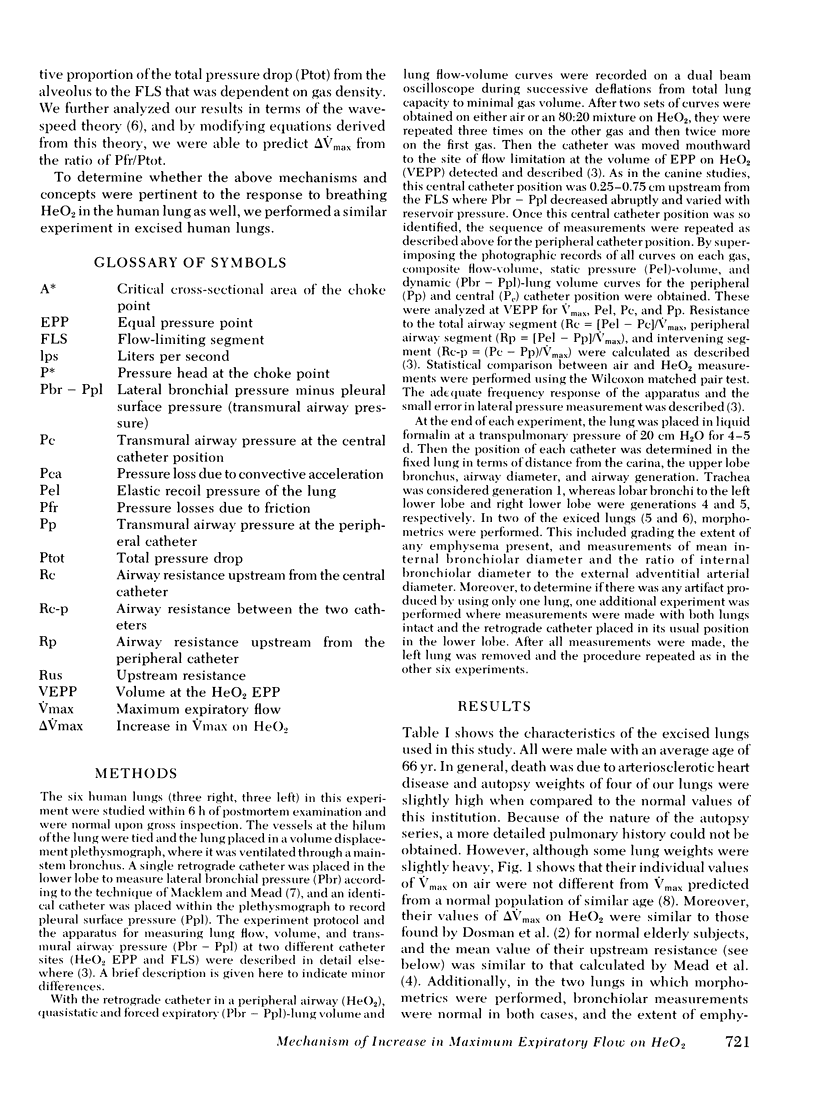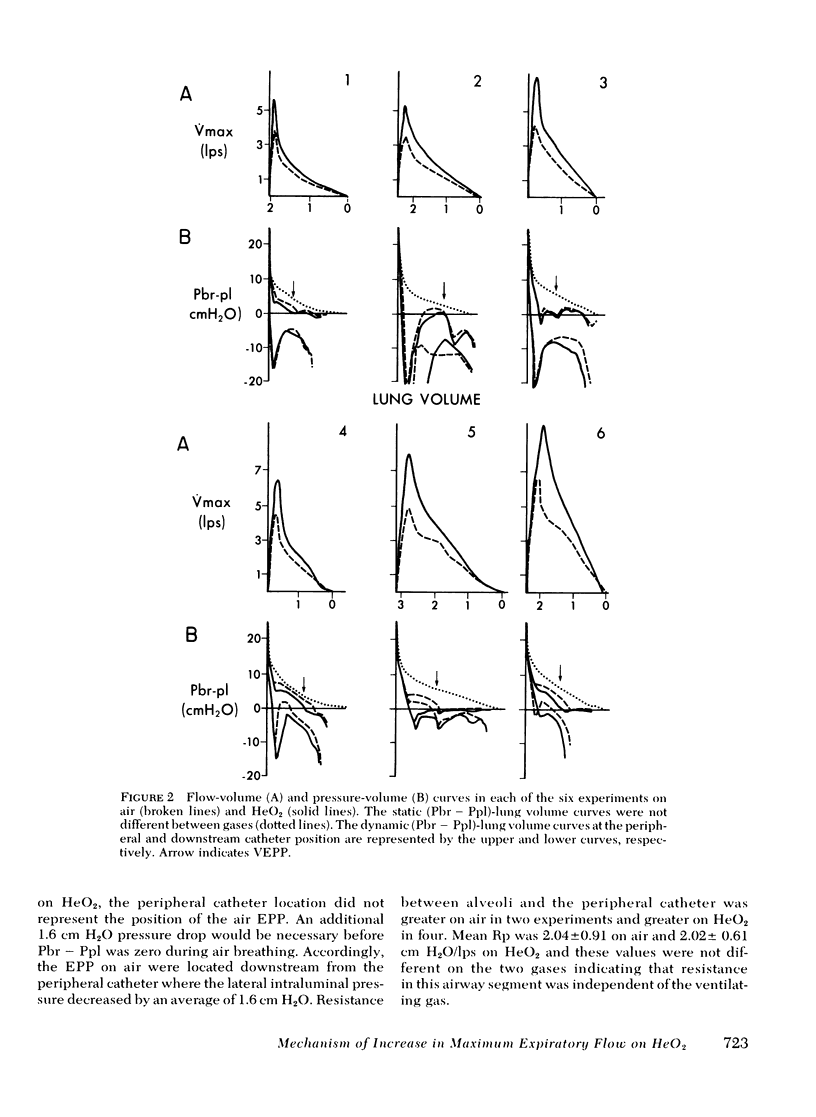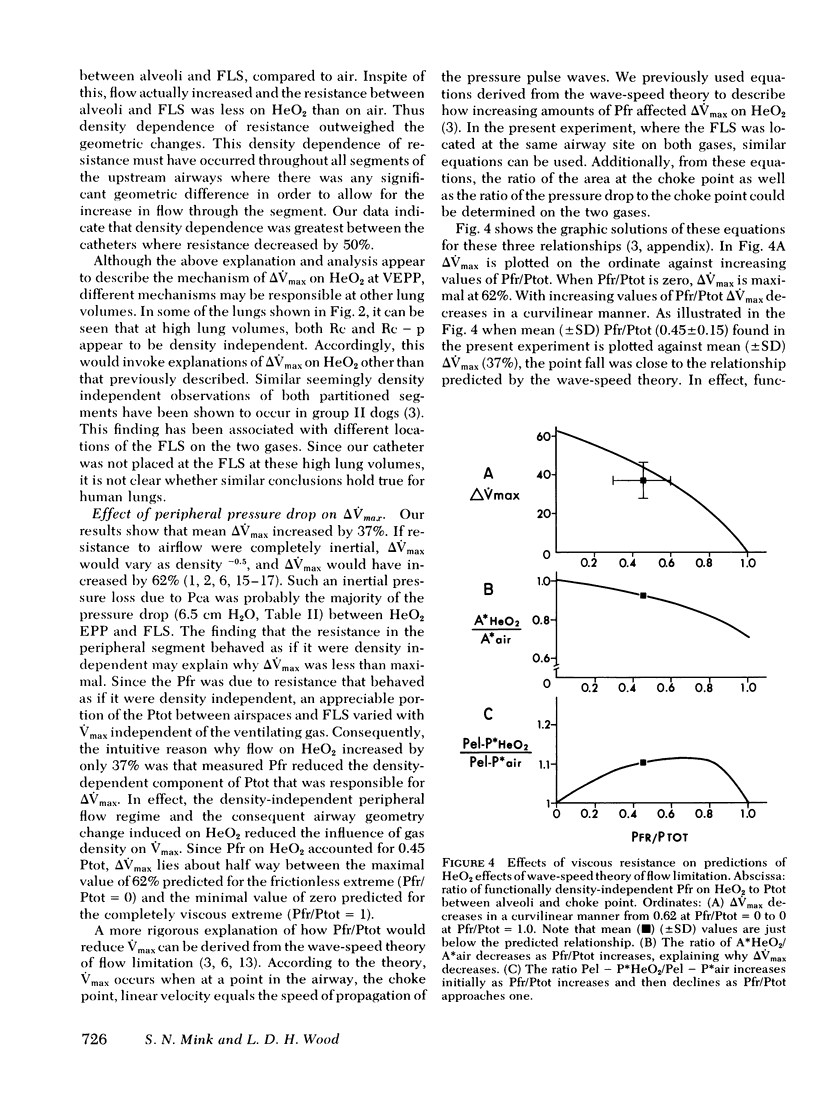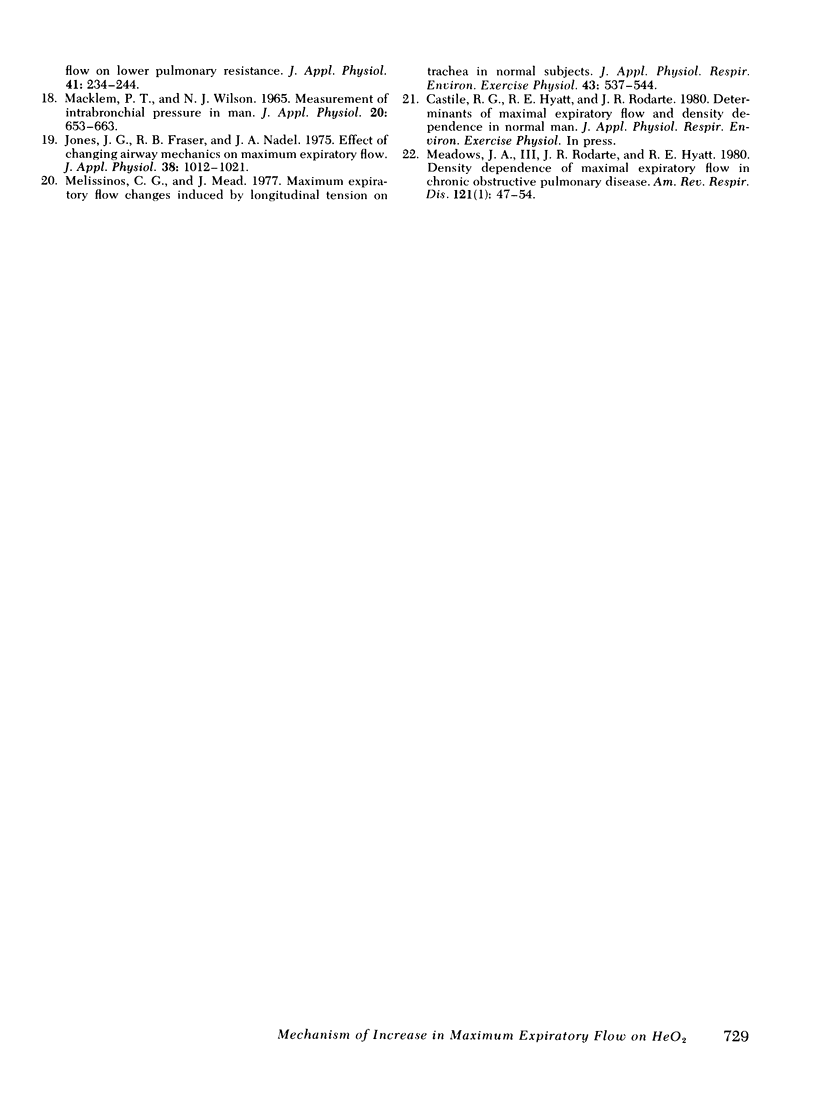Abstract
We used the retrograde catheter technique to investigate the effect of HeO2 on resistance to maximum expiratory flow (Vmax) in airways subsegments between alveoli and the equal pressure point (EPP), and between EPP and the flow-limiting segment (FLS). FLS were found at the same airway site in sublobar bronchi (i.d., 0.54 +/- 0.13 cm) on both air and HeO2 in the six human excised lungs studied. Static elastic recoil pressure (5 +/- 1 cm H2O) and the lateral pressure at FLS (critical transmural airway pressure -6 +/- 3 cm H2O) were not different on the two gases. delta Vmax averaged 37 +/- 8.9% and was similar to the value found in healthy subjects of similar age (66 +/- 10 yr). EPP were located on HeO2 in peripheral airways (i.d., 0.33 +/- 0.03 cm), and EPP on air were located more downstream. Resistance between EPP and FLS was highly density dependent. Resistance between alveoli and EPP behaved as if it were density independent, due in part to Poiseuille flow in the peripheral airways and in part to the consequent narrowing of peripheral airways on HeO2. This density-independent behavior in peripheral airways reduced delta Vmax on HeO2 from its predicted maximal amount of 62%. Assuming that FLS is the "choke point" these findings are consistent with wave-speed theory of flow limitation modified to include functionally density-independent pressure losses in peripheral airways. These results and conclusions are similar to those found in living dogs. They question previous interpretation of delta Vmax as an index of peripheral airway obstruction, and demonstrate the utility of the wave-speed theory in explaining complicated mechanisms of expiratory flow limitation.
Full text
PDF









Selected References
These references are in PubMed. This may not be the complete list of references from this article.
- Dawson S. V., Elliott E. A. Wave-speed limitation on expiratory flow-a unifying concept. J Appl Physiol Respir Environ Exerc Physiol. 1977 Sep;43(3):498–515. doi: 10.1152/jappl.1977.43.3.498. [DOI] [PubMed] [Google Scholar]
- Despas P. J., Leroux M., Macklem P. T. Site of airway obstruction in asthma as determined by measuring maximal expiratory flow breathing air and a helium-oxygen mixture. J Clin Invest. 1972 Dec;51(12):3235–3243. doi: 10.1172/JCI107150. [DOI] [PMC free article] [PubMed] [Google Scholar]
- Dosman J., Bode F., Urbanetti J., Martin R., Macklem P. T. The Use of a Helium-Oxygen Mixture during Maximum Expiratory Flow to Demonstrate Obstruction in Small Airways in Smokers. J Clin Invest. 1975 May;55(5):1090–1099. doi: 10.1172/JCI108010. [DOI] [PMC free article] [PubMed] [Google Scholar]
- Elliott E. A., Dawson S. V. Test of wave-speed theory of flow limitation in elastic tubes. J Appl Physiol Respir Environ Exerc Physiol. 1977 Sep;43(3):516–522. doi: 10.1152/jappl.1977.43.3.516. [DOI] [PubMed] [Google Scholar]
- Gardiner A. J., Wood L., Gayrard P., Menkes H., Macklem P. Influence of constriction in central or peripheral airways on maximal expiratory flow rates in dogs. J Appl Physiol. 1974 May;36(5):554–560. doi: 10.1152/jappl.1974.36.5.554. [DOI] [PubMed] [Google Scholar]
- Horsfield K., Dart G., Olson D. E., Filley G. F., Cumming G. Models of the human bronchial tree. J Appl Physiol. 1971 Aug;31(2):207–217. doi: 10.1152/jappl.1971.31.2.207. [DOI] [PubMed] [Google Scholar]
- Hughes J. M., Jones H. A., Wilson A. G., Grant B. J., Pride N. B. Stability of intrapulmonary bronchial dimensions during expiratory flow in excised lungs. J Appl Physiol. 1974 Nov;37(5):684–694. doi: 10.1152/jappl.1974.37.5.684. [DOI] [PubMed] [Google Scholar]
- Jones J. G., Fraser R. B., Nadel J. A. Effect of changing airway mechanics on maximum expiratory flow. J Appl Physiol. 1975 Jun;38(6):1012–1021. doi: 10.1152/jappl.1975.38.6.1012. [DOI] [PubMed] [Google Scholar]
- Macklem P. T., Mead J. Factors determining maximum expiratory flow in dogs. J Appl Physiol. 1968 Aug;25(2):159–169. doi: 10.1152/jappl.1968.25.2.159. [DOI] [PubMed] [Google Scholar]
- Macklem P. T., Mead J. Resistance of central and peripheral airways measured by a retrograde catheter. J Appl Physiol. 1967 Mar;22(3):395–401. doi: 10.1152/jappl.1967.22.3.395. [DOI] [PubMed] [Google Scholar]
- Macklem P. T., Wilson N. J. Measurement of intrabronchial pressure in man. J Appl Physiol. 1965 Jul;20(4):653–663. doi: 10.1152/jappl.1965.20.4.653. [DOI] [PubMed] [Google Scholar]
- Mead J., Turner J. M., Macklem P. T., Little J. B. Significance of the relationship between lung recoil and maximum expiratory flow. J Appl Physiol. 1967 Jan;22(1):95–108. doi: 10.1152/jappl.1967.22.1.95. [DOI] [PubMed] [Google Scholar]
- Meadows J. A., 3rd, Rodarte J. R., Hyatt R. E. Density dependence of maximal expiratory flow in chronic obstructive pulmonary disease. Am Rev Respir Dis. 1980 Jan;121(1):47–53. doi: 10.1164/arrd.1980.121.1.47. [DOI] [PubMed] [Google Scholar]
- Melissinos C. G., Mead J. Maximum expiratory flow changes induced by longitudinal tension on trachea in normal subjects. J Appl Physiol Respir Environ Exerc Physiol. 1977 Sep;43(3):537–544. doi: 10.1152/jappl.1977.43.3.537. [DOI] [PubMed] [Google Scholar]
- Mink S., Ziesmann M., Wood L. D. Mechanisms of increased maximum expiratory flow during HeO2 breathing in dogs. J Appl Physiol Respir Environ Exerc Physiol. 1979 Sep;47(3):490–502. doi: 10.1152/jappl.1979.47.3.490. [DOI] [PubMed] [Google Scholar]
- Pride N. B., Permutt S., Riley R. L., Bromberger-Barnea B. Determinants of maximal expiratory flow from the lungs. J Appl Physiol. 1967 Nov;23(5):646–662. doi: 10.1152/jappl.1967.23.5.646. [DOI] [PubMed] [Google Scholar]
- Protti D. J., Craven N., Naimark A., Cherniack R. M. Computer assistance in the clinical investigation of pulmonary function studies. Methods Inf Med. 1973 Apr;12(2):102–107. [PubMed] [Google Scholar]
- Smaldone G. C., Bergofsky E. H. Delineation of flow-limiting segment and predicted airway resistance by movable catheter. J Appl Physiol. 1976 Jun;40(6):943–952. doi: 10.1152/jappl.1976.40.6.943. [DOI] [PubMed] [Google Scholar]
- Wood L. D., Bryan A. C. Exercise ventilatory mechanics at increased ambient pressure. J Appl Physiol Respir Environ Exerc Physiol. 1978 Feb;44(2):231–237. doi: 10.1152/jappl.1978.44.2.231. [DOI] [PubMed] [Google Scholar]
- Wood L. D., Engel L. A., Griffin P., Despas P., Macklem P. T. Effect of gas physical properties and flow on lower pulmonary resistance. J Appl Physiol. 1976 Aug;41(2):234–244. doi: 10.1152/jappl.1976.41.2.234. [DOI] [PubMed] [Google Scholar]


